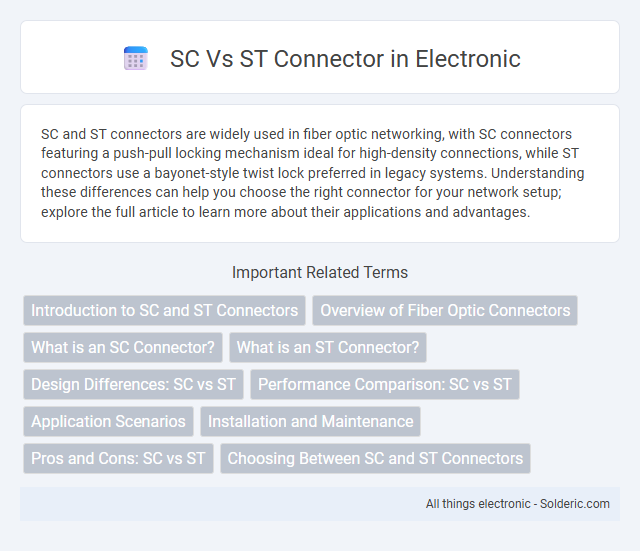SC and ST connectors are widely used in fiber optic networking, with SC connectors featuring a push-pull locking mechanism ideal for high-density connections, while ST connectors use a bayonet-style twist lock preferred in legacy systems. Understanding these differences can help you choose the right connector for your network setup; explore the full article to learn more about their applications and advantages.
Comparison Table
| Feature | SC Connector | ST Connector |
|---|---|---|
| Connector Type | Push-pull, snap-in | Bayonet twist-lock |
| Insertion Loss | Typically 0.2 - 0.5 dB | Typically 0.25 - 0.75 dB |
| Ferrule Diameter | 2.5 mm | 2.5 mm |
| Key Application | Datacom, telecom networks | Long-distance and campus networks |
| Durability | High, less wear with frequent connections | Moderate, prone to alignment issues |
| Ease of Use | Quick push-pull action | Requires twisting for secure connection |
| Compatibility | Multi-mode and single-mode fiber | Multi-mode and single-mode fiber |
| Cost | Generally lower | Generally higher |
Introduction to SC and ST Connectors
SC connectors feature a push-pull coupling mechanism, offering quick and easy fiber optic cable connections with low insertion loss and high reliability in telecommunications and data networks. ST connectors utilize a bayonet-style twist lock design, known for durability and stable connections, frequently used in legacy fiber optic systems and multimode networks. Both connectors support single-mode and multimode fibers but differ in ease of installation and typical application environments.
Overview of Fiber Optic Connectors
SC and ST connectors are widely used fiber optic connectors known for their reliability and ease of use in network installations. The SC connector features a push-pull coupling mechanism with a square-shaped design, providing low insertion loss and high precision alignment, ideal for high-density applications. In contrast, the ST connector uses a bayonet-style twist lock mechanism with a round ferrule, commonly deployed in legacy and multimode fiber networks for durable and quick connections.
What is an SC Connector?
An SC connector, or Subscriber Connector, is a widely used fiber optic connector known for its push-pull locking mechanism and square-shaped design, which ensures stable and reliable connections in networking environments. It is commonly used in single-mode and multimode fiber optic cables, offering low insertion loss and high return loss performance ideal for telecommunications and data communications. The SC connector supports quick and easy installation, making it a preferred choice for patch panels, distribution frames, and data center applications.
What is an ST Connector?
An ST connector is a fiber optic connector known for its bayonet-style locking mechanism, widely used in network environments requiring secure and reliable connections. Featuring a cylindrical ferrule, it ensures precise alignment of the fiber, minimizing signal loss and maintaining high data transmission speeds. Your choice of an ST connector suits older multimode fiber systems and applications requiring durable performance in harsh conditions.
Design Differences: SC vs ST
SC connectors feature a push-pull design that ensures quick and easy insertion and removal, while ST connectors use a bayonet-style twist-lock mechanism providing secure and stable connections. The SC connector typically has a square-shaped housing, offering compact and robust performance, whereas the ST connector has a round, cylindrical body designed for durability in rugged environments. Your choice between SC and ST connectors depends on the ease of use required and the specific application environment.
Performance Comparison: SC vs ST
SC connectors offer superior performance in terms of insertion loss and return loss compared to ST connectors, making them ideal for high-precision fiber optic networks. The push-pull coupling mechanism of SC connectors provides better stability and reduced signal attenuation, while the bayonet-style locking of ST connectors can result in slightly higher insertion loss under mechanical stress. SC connectors are preferred in modern high-speed telecommunications and data center applications due to their consistent low signal loss and ease of installation.
Application Scenarios
SC connectors are widely used in data centers and telecom networks due to their quick push-pull mechanism and reliable performance in high-density environments. ST connectors are preferred in legacy fiber optic systems and industrial settings where they offer secure twist-on connections resistant to mechanical stress. Your choice depends on whether ease of installation or durability in harsh conditions is more critical to your application scenario.
Installation and Maintenance
SC connectors feature a push-pull locking mechanism that simplifies installation by allowing quick, tool-free connections, making them ideal for high-density setups. ST connectors utilize a bayonet mount, requiring insertion and a twist to lock, which can be more time-consuming but ensures secure connections in rugged environments. Maintenance for SC connectors is streamlined due to their ease of cleaning and lower risk of damage during frequent mating cycles, whereas ST connectors may require more careful handling to avoid fiber damage during reconnections.
Pros and Cons: SC vs ST
SC connectors offer quick push-pull coupling and high precision alignment, making them ideal for high-density installations and minimizing insertion loss. ST connectors use a bayonet-style twist lock, providing secure connections in rugged environments but can be less convenient for frequent reconnections. Your choice depends on whether quick, tool-free connections (SC) or durable, twist-lock mechanisms (ST) better suit your network's reliability and maintenance needs.
Choosing Between SC and ST Connectors
Selecting between SC and ST connectors depends on the specific requirements of the fiber optic network, including installation environment and performance needs. SC connectors feature a push-pull coupling mechanism that ensures high precision and easy maintenance, making them ideal for data centers and high-density patch panels. ST connectors utilize a bayonet twist-lock design favored in legacy telecom and campus networks where durability and quick connect-disconnect are essential.
SC vs ST Connector Infographic

 solderic.com
solderic.com